Many people think that in modern conditions painters have not used a brush for a long time and all work is carried out using a spray gun, which allows you to apply paint to the surface to be painted. Even despite the convenience of using such modern equipment, a paint brush is an indispensable tool. With it, you can color corners and various elements of small sizes. Such painstaking procedures are impossible without this tool.
- Application area
- Work with a paint brush
- Preparatory stage
- Brush Care Rules
- Brush classification
- Selection tips
- Conclusion
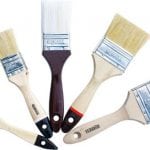
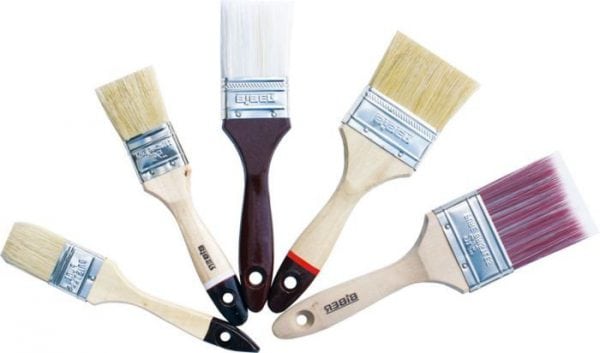
Application area
The most common paint brush received for domestic work. In particular, it is most often used for such works:
- applying glue for wallpaper;
- painting walls, doors or floors;
- coloring of window frames and other structural elements;
- painting garden benches;
- updating worn furniture of different sizes.
The latter direction of using brushes is becoming increasingly popular. When used correctly, a paint brush will allow you to restore furniture or vice versa to make it older or more refined. For example, you can apply to the surface the painting in the form of trees, marble or other patterns.
to contents ↑Work with a paint brush
Modern professional brushes have a fairly simple design. The main part of the product is the handle, on which the work surface is fixed with the help of a bandage, having the form of a long tuft of pile.
To correctly apply the paintwork material, it is necessary to wet the brush in the paint and transfer it to the surface. At the same time, for even distribution, there must be pressure on the brush. The effectiveness of painting depends on the appearance of the work surface.
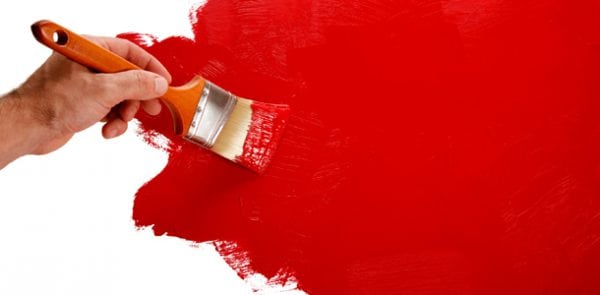
Preparatory stage
After you have purchased a brush for applying paint, it is not recommended to start painting immediately. If you do not prepare the tool, then too stiff bristles may leave streaks in the areas to be painted. In order not to bring this up, you should lower the brush in a water-based solution for about one hour. All this will lead to the fact that the bristle of the tool becomes larger in volume and softer, so that it will be easier to apply the composition to the surface.
If you want to apply oil paint, then the brush needs to be kept dry. However, even then, strips left by protruding bristle hairs may remain. To permanently eliminate them, you should first work with the tool on a hard brick or plaster surface. Before this, the round brush is wetted with a paint or varnish composition or water. This will smooth out the protruding bristles and more evenly apply paint.
to contents ↑Brush Care Rules
The brush, like other tools, can gradually wear out. Therefore, in order to increase their service life and maintain the quality of the paint application, some care rules should be followed. For example, during painting work, the enamel brush needs to be rotated so that it wears out evenly. It is also recommended not to apply too much pressure so as not to lead to increased wear of the product.
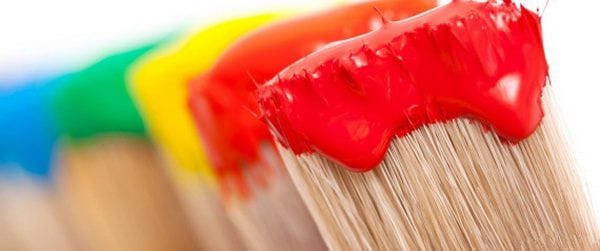
After each stage of the work, the synthetic round brush should be suspended above the water tank without touching the bottom. This is necessary so that the pile does not bend or become unusable. Also, the brush can be suspended in the container with the paint that you use. If you work with wooden tools, then it is better not to dip them in a water-based liquid to prevent their hair from falling out.
to contents ↑After completing the painting work, it is recommended to wash the paint tool in kerosene to completely eliminate paint residues. After that, the brush is washed in soapy water until the water no longer stains. Next, the tool should be suspended for further drying and stored in this condition.
Brush classification
The main types of brushes for painting differ in such signs:
Beam shape:
- Flat brushes are the most common among professional painters. They are distinguished by an elastic working part, which is convenient to use when working with liquid and thick formulations. With the help of such brushes, you can paint both wide and narrow elements of the house. In this case, it all depends on the width of the bristles. The peculiarity of a flat brush is that it collects paint well and easily gives it away when carried on the surface.
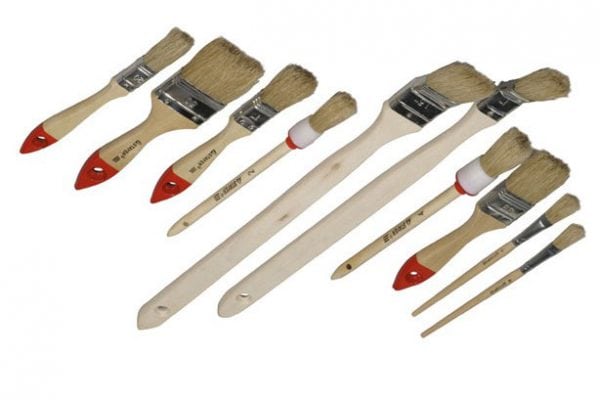
- Round brushes are used for special works where it is inconvenient to use a flat tool. For example, a tool with a bristle of this shape can be used to paint a U-shaped profile or work with hard-to-reach areas of the house. In addition, a round brush will be an excellent option for painting window bindings. To work with such a tool, you must use sufficient pressure.
Workspace size:
- Narrow brushes have a beam width of 1 to 3 cm. They are well suited for working with thin elements, painting pipes, inaccessible places, as well as for applying decorative patterns in the form of trees. With their help we draw any decorative elements.
- Medium brushes are used to paint doors, furniture and other elements of the house. They have a working width of 3.5 to 6 cm.
- Wide painting tools are often used for painting floors, walls, ceilings, roofs and other objects with a large area. The beam width of such models reaches 10 cm, which makes it possible to quickly process large sections.
Pile Material:
- Natural brushes are made from materials such as badger or cow hair, pig bristles and so on. In each bundle, the hair has a split structure, therefore, its working surface easily absorbs the paintwork. In addition, natural pile is very soft and supple, which greatly simplifies the dyeing procedure. Mostly tools made from natural materials are used for working with oil paint or drying oil.
- Synthetic products also absorb paintwork well. A high-quality synthetic flat brush has good hair splitting. An important advantage of synthetic brushes, in comparison with natural ones, is higher wear resistance.In general, they are more suitable for working with water-based paints.
- Combination brushes are more and more common recently. Their bristles combine both natural and synthetic nap. Therefore, such products have a rigid work surface that absorbs paint well.
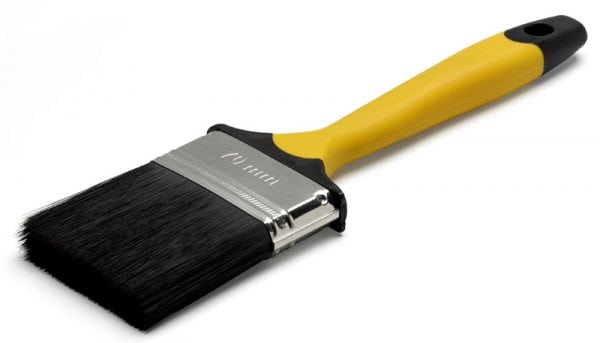
Purpose:
- Manual types of paint brushes (RK) are the most common, as they are used for applying a primer, glue, as well as painting sections of a medium-sized house. This type of tool can have a bunch of both round and flat shapes. The category of hand held radiator or corner brushes, which are easy to paint the edges of the batteries.
- Flat brushes (KP) can be considered one of the most universal. They can be used to paint surfaces of various sizes, apply glue and perform decorative finishes.
- The fly brush has a wide beam, so it is convenient for her to work with surfaces of a large area. Basically, the fly brush is used for washing ceilings and walls, priming large surfaces, as well as applying whitewashing. The working surface of such a tool is often located on a handle up to 20 cm long. However, for convenience, most models have removable mounts that allow them to be attached to sticks up to 2 meters long. This makes it easy to work with such a brush, even on the ceiling.
- Flute brushes (CF) are distinguished by a working surface made of drawn hair. Such bristles are very elastic and soft, which facilitates the work with the surface. They are mainly used for finishing painting, which allows you to hide traces of paint that remained after working with a hard brush.
- Moklovitsy (KMA) are distinguished by the fact that the bundle is made of natural horse hair in combination with synthetic materials. Typically, such brushes have a rectangular shape that resembles a brush. Macklowers are mainly used for applying glue for wallpaper or mortar. At the same time, they are used less frequently for painting, since they collect too much paint due to stiff bristles.
- Panel brushes (CPC) are tools that have a relatively narrow working surface of up to 2 cm. They are used to apply paint in the form of narrow strips (panels). Also, a panel tool is suitable for painting corners and areas at the junction of two shades. Fiberglass brush belongs to this category.
- Brush products (ЩТ) are also called brush-trimming. This type is used to give a painted surface a texture. For this, a fresh layer of paint is treated with such a brush to give it an original decorative relief.
Selection tips
When choosing a brush, you need to know that each of them has its own technical characteristics. Moreover, for each stage of work, several types of tools may be needed.
In particular, a fly brush is better for painting the main surface, and for hard-to-reach areas of the house, a round synthetic brush. Therefore, when choosing, you should first focus on what kind of work you are going to carry out.
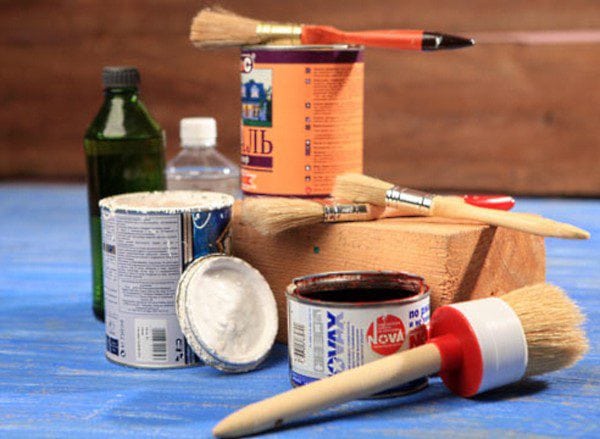
In addition, it is recommended to pay attention to the material from which the handle is made. Wooden handle is lighter and cheaper. However, the plastic handle, although it costs more, is notable for its durability and wear resistance.
In addition, it can be quickly cleaned of paint. If you want to get a durable tool, it is better to choose brushes with beam fixation using a brass element that does not lend itself to corrosion.
to contents ↑Conclusion
Thus, brushes are used for almost all painting work. When choosing them, you need to focus on their technical characteristics and scope.



